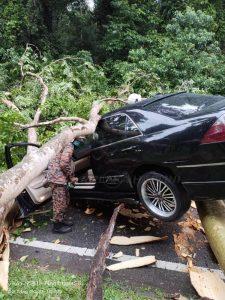
Chulias and Marakayars: A Persistent Presence in the Tanah Air
MANY have become Malays, and constitutionally defined as such. Not a few maintain their Tamil identity, being Indian Muslim. At the same time, culture and social identities evolve and oscillate.
The Chulia Street in Tanjong was named in 1798 replacing Malabar Street. The British suddenly realised that most of the Indians who moved to the street at that time were from Tamil Nadu. Many would have been from the Marakayar group, those who built keramats (shrines) and mosques in the area, including the Masjid Kapitan Keling, built in 1801. The mosque was named after a wealthy Marakayar merchant, Abdul Kadir Mohideen Merican.
Historically the Chulias were mainly Marakayars. Mainly in Malaysia and Singapura; also Indonesia and Thailand, they would variably carry the surnames “Merican,” “Marican,” sometimes “Marikar” or “Marakayar.” Another group of south Indian Muslims are the Malabaris. In those days, Chulias/Marakayar families would call the Malabaris as Kakas. It is a polite reference to the Muslims from the Malabar coast. There is a Kampung Kaka Street linking Carnavon Street with Kampung Kolam.
In Singapura, the origins of Chulia Street was Kling Street. Owing to obvious reasons, the Chulias then petitioned and had it renamed Chulia Street on 1 January 1922.
Intermarriages between Arab settlers and populations both along the Malabar and Coromandel coasts are common throughout history. As a result, creolized communities emerged. The Coromandel coast, along the south and eastern seaboard of the Indian subcontinent (also in Sri Lanka, across the Palk Straits) is a much popular historical and geographical marker associated with the Malay Archipelago for centuries.
Distinctive Arab colonies were formed east of the Southern tip of the subcontinent such as in Kalyapatnam, Karikal and Cuddalore. The intermarriages resulted in specific Arabized-Tamil identities mainly in the Marakayars and the Labbais; and to some extent, other Tamil Muslim groups. Collectively they are known later as the Chulias. The Marakayars have their own script known as Arwi (Tamil using the Jawi script), and known to be endogamous. I know of Merican families in Tanjong who would arrange for marriages to their own kind from India.
From Portuguese chronicler Tome Pires, we know of a large overwhelming presence of Gujeratis in Melaka in the 1400s, and a large community of Benggalis in Pasai. These form important trading groups from the Indian sub-continent.
But it was the Marakayars in the Chulias, who maintained their separate identity through powerful religious institutions and the evolution of Arwi – the autonomous Arabic-Tamil language, that stood out and persisted under difficult conditions of monopoly and colonialism. According to S. Arasaratnam (1989) in a lecture titled “Islamic Merchant Communities of the Indian Subcontinent in Southeast Asia,” led by the Marakayars and the Labbais, the Chulias were mainly ship-owning merchants engaged in coastal and overseas trade.
They lived in and around the major southern ports in urban conglomerations of some magnitude and affluence. Earlier, there was a period when they shared trade with indigenous Hindu merchants, but by the 17th century, the ports along the Coromandel coasts had become predominantly Chulia Muslim ports, with Tamil Muslims being the major settlers.
In Tamil Nadu, like in Tanjong, the community had a number of mosques, Sufi centers of learning and darghahs of famed men of learning and piety. The Chulia port of Nagore, became a famous centre to the shrine of a 16th century Sufi mystic Sayyid Shahul Hameed, a descendant of Sheikh Abdul Qadir Jilani. One can see this in the Nagore Durgha Sheriff in Chulia Street, Tanjong, built in the early 1800.
It was noted that the Chulias built substantial shipping fleets in those ports and in Sri Lanka. Regular trade between the Southern Coromandel ports with Pasai, Pedir, Jambi, Acheh, Johore and Melaka were already established in the 14th and 15th centuries. The commodities traded were textiles, pepper, tin, aromatic woods, elephants and rice. The elephant trade lasted through the 19th century. Trang in Thailand, with a Chulia population, was once centre for export of the pachyderms to India. And the Merican family there having networks, mainly textiles, from Bangkok to Singapura.
The port of Nagapatnam was the centre of Chulia shipping in the 15th century. As the Portuguese weakened their hold in Melaka by the end of the 16th century, the Chulias then sailed more boldly to Kedah, Perak, Johore, Acheh and proceeded through the Javanese ports of Banten and Japara, and on to Makasar.
Arasaratnam observed that the Chulias developed a type of presence and a manner of operation that was to enable them to persist as traders, through an increasingly hostile environment till the end of the 18th century. In the process, they outmanoeuvred their Hindu compatriots. One merchant of Cuddalor, Nellabuka Marikar, freightening goods in his ships to Acheh have had great influence with port authorities – they used both Dutch and English passes and circumvented Dutch blockades.
In their search to trade, they had settled in large numbers in the southern Siamese provinces and the island of Ujung Salang (Phuket) in the 17th century. There were also some Chulia settlements in the port of Mergui and the province of Tenasserim on the overland route to
Ayuthya, but subordinated to the Golconda Muslims and the Indo-Persians. By the end of the 18th century, there were populous Chulia settlements in Kuala Kedah and up to the Kedah river close to Alor Star.
The Light Letters (1771-1994) also told us about the movement of the Marakayas and Malabaris. Later they moved to Tanjong in large numbers, many from Kuala Bahang (now Kuala Kedah). Their ships from Porto Novo (now Perrangi Pettai), Nagore or Nagapatnam would sail to Pulau Pinang, and then to Mergui, Phuket, Melaka, Acheh and Pedir. The ships ranged from 100 to 300 tonnes and carried goods such as textiles, rice, tobacco, salt from India; and pepper, tin, ginger, gambier, betel nuts, rattan, and gold dust on the return journey.
Langgani saluran Telegram kami untuk dapatkan berita-berita yang terkini.


